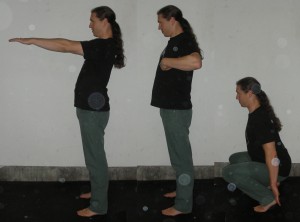
Loading the hips and the bodyweight squat. In order to achieve this you’re going to need flexibility, strength and coordination. But in all honesty, why should that even matter to you? You’ve probably read tons of info online about how to do a squat, yet it doesn’t hold much significance unless you understand the benefits that go along with it.
If you remember from my last post, we discussed bodyweight exercise and its enhanced role inhelpying you develop your “skill” in utilizing your own body. Not that you can’t do the same with weights, but how easy is it to focus on correct muscle activation when you’re running through a movement while under a “heavy” load. Also, it increases the possible chance of strain or injuring depending on what you’re doing.
Which brings us back to the bodyweight squat. Understanding how to perform it will help you understand the sequence of muscles you should be using and in what order.
Here’s a few examples to fuel your thought processes:
How far do you pull your hips down? What direction should your knees be pointing?(i.e. knee valgus) When do your abdominals come into play? These are all things you should have locked in before you work the squat.
Now this brings us to our next question. Why does all this matter? Wouldn’t you be able to complete the reps and sets and sets your trainer gave you and be done with it so that you can get that beach body you’ve always wanted? Yes you can but you would be missing out on two different pieces. The first is that understanding which muscle to load as the primary, secondary, etc. will give you the opportunity to increase your performance and do more. The second is to avoid possible injuries in the future. You can look up things like exhaustive-adaptive response if you’re wondering what I’m hinting at.
Now I’ll give you a real world example of how understanding the squat can affect your movement. Say you’re going for a run. Utilizing your hips and glutes are more important to this movement pattern than you may think. If you can’t engage your hips and glutes while running, you lose out on some strong stabilizers and shock absorbers. They help to lift you away from the ground, thereby reducing shock and once engaged can take stress away from the knees, shins, and ankles. Which tend to be common injuries for people who take on running.
So, I’m going to close off with this as just being a quick intro to the squat. I’m going to be delving more into the squat in future entries, but if you want more than just a primer, pick up The Ultimate Guide to Bodyweight Bodyweight Squats and Pistols.
Stay Inverted!
-Jonathan Magno




No comments yet.